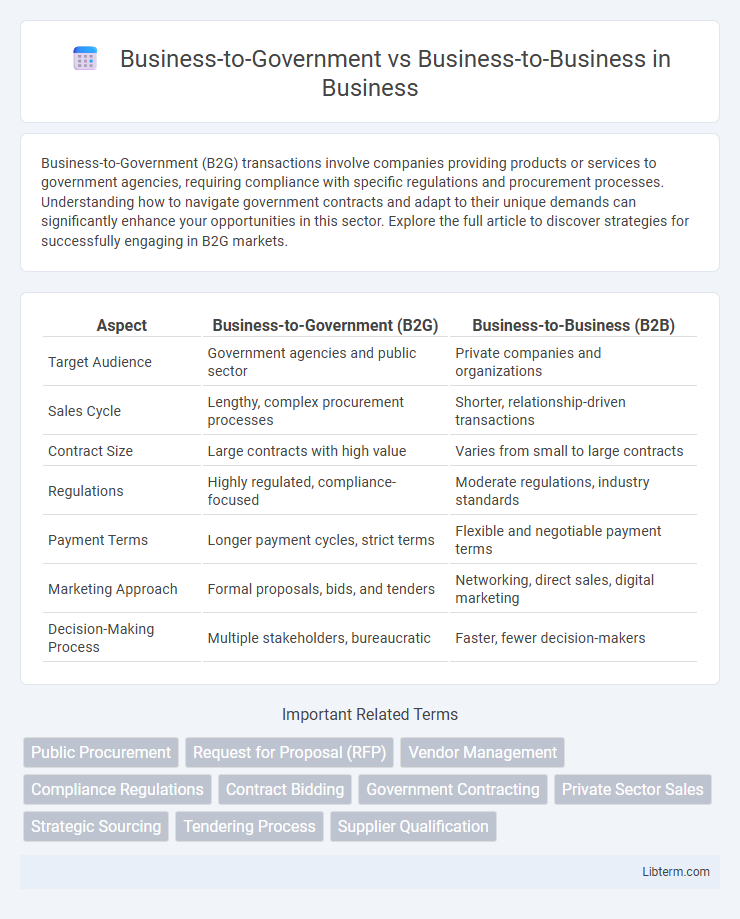Business-to-Government (B2G) transactions involve companies providing products or services to government agencies, requiring compliance with specific regulations and procurement processes. Understanding how to navigate government contracts and adapt to their unique demands can significantly enhance your opportunities in this sector. Explore the full article to discover strategies for successfully engaging in B2G markets.
Table of Comparison
| Aspect | Business-to-Government (B2G) | Business-to-Business (B2B) |
|---|---|---|
| Target Audience | Government agencies and public sector | Private companies and organizations |
| Sales Cycle | Lengthy, complex procurement processes | Shorter, relationship-driven transactions |
| Contract Size | Large contracts with high value | Varies from small to large contracts |
| Regulations | Highly regulated, compliance-focused | Moderate regulations, industry standards |
| Payment Terms | Longer payment cycles, strict terms | Flexible and negotiable payment terms |
| Marketing Approach | Formal proposals, bids, and tenders | Networking, direct sales, digital marketing |
| Decision-Making Process | Multiple stakeholders, bureaucratic | Faster, fewer decision-makers |
Understanding Business-to-Government (B2G) and Business-to-Business (B2B)
Business-to-Government (B2G) involves commercial transactions where businesses provide products or services directly to government entities, often requiring compliance with strict regulations and procurement procedures. Business-to-Business (B2B) focuses on transactions between companies, emphasizing supply chain integration, bulk purchasing, and long-term partnerships to enhance operational efficiency. Understanding the distinct procurement cycles, decision-making processes, and contract requirements in B2G versus the relationship-driven dynamics and scalability concerns in B2B is crucial for optimizing sales strategies.
Key Differences Between B2G and B2B Models
Business-to-Government (B2G) transactions involve businesses providing products or services directly to government agencies, emphasizing compliance with regulatory standards, long procurement cycles, and detailed bidding processes. Business-to-Business (B2B) models focus on commercial transactions between companies, prioritizing relationship building, volume sales, and flexible pricing strategies. Key differences include target customers, procurement complexity, contract length, and decision-making processes, with B2G requiring stringent adherence to government regulations and longer approval timelines compared to the more dynamic and negotiation-driven B2B environment.
Market Structure: B2G vs B2B
Business-to-Government (B2G) markets often involve complex regulatory environments, longer sales cycles, and larger contract values driven by public sector procurement processes. Business-to-Business (B2B) markets typically feature more competitive dynamics with frequent transactions, diverse industry sectors, and customized solutions tailored to corporate clients. The B2G market structure emphasizes compliance and standardized bidding, whereas B2B markets prioritize relationship-driven sales and continuous innovation to address varied business needs.
Sales Cycle and Procurement Processes
Business-to-Government (B2G) sales cycles are typically longer and involve rigorous procurement processes, including formal bidding, compliance with regulatory requirements, and extensive documentation, often extending over several months. Business-to-Business (B2B) transactions generally have shorter sales cycles with more flexible negotiation terms, focused on relationship-building and customized solutions to meet specific company needs. Understanding the complexities of public sector procurement frameworks and corporate purchasing behaviors is crucial for optimizing sales strategies in both B2G and B2B markets.
Compliance and Regulatory Demands
Business-to-Government (B2G) transactions face stringent compliance and regulatory demands, including adherence to government procurement standards, transparency mandates, and security protocols that vary by jurisdiction. In contrast, Business-to-Business (B2B) interactions primarily focus on industry-specific regulations, contract law, and data privacy requirements, which tend to be less rigid than B2G frameworks. Understanding these differing regulatory landscapes is crucial for companies to ensure legal adherence, avoid penalties, and maintain competitive advantage in both markets.
Target Audience and Relationship Management
Business-to-Government (B2G) targets public sector entities, requiring compliance with regulatory standards and a focus on transparency and accountability in procurement processes. In contrast, Business-to-Business (B2B) targets private companies, emphasizing customization, long-term strategic partnerships, and agile communication to meet evolving market demands. Relationship management in B2G involves navigating bureaucratic procedures and building trust with multiple stakeholders, while B2B demands personalized engagement and collaborative innovation to drive mutual business growth.
Contract Value and Revenue Opportunities
Business-to-Government (B2G) contracts typically involve higher contract values due to large-scale procurement and longer contract durations, providing stable revenue streams for businesses. Business-to-Business (B2B) transactions generally offer more frequent but lower-value contracts, driving agile revenue opportunities through diversified client portfolios. Understanding these dynamics helps companies tailor strategies for maximizing contract wins and optimizing revenue growth in each market segment.
Marketing Strategies: B2G vs B2B
Marketing strategies in Business-to-Government (B2G) emphasize compliance with government regulations, long procurement cycles, and building trust through transparency and formal proposals, while leveraging relationship management to navigate bureaucratic processes. In Business-to-Business (B2B) marketing, strategies prioritize targeting decision-makers with personalized value propositions, focusing on ROI-driven messaging, and utilizing account-based marketing to foster long-term partnerships. Both B2G and B2B sectors benefit from data-driven insights, but B2G requires a deeper understanding of public sector needs and compliance standards.
Challenges Unique to B2G and B2B Markets
Business-to-Government (B2G) markets face challenges such as stringent regulatory compliance, lengthy procurement cycles, and complex bidding processes that require detailed documentation and adherence to public sector standards. Business-to-Business (B2B) markets encounter difficulties including building long-term relationships, navigating competitive pricing strategies, and managing diverse customer needs across different industries. Both B2G and B2B transactions demand tailored marketing approaches, but B2G often requires a deeper understanding of government policies, while B2B focuses more on scalability and customization of products and services.
Future Trends in B2G and B2B Sectors
Future trends in Business-to-Government (B2G) highlight increasing digital transformation and adoption of AI-driven procurement systems, enhancing transparency and efficiency in public sector contracts. In the Business-to-Business (B2B) sector, blockchain technology and advanced data analytics are reshaping supply chain management and customer personalization. Both sectors are expected to leverage cybersecurity advancements and sustainable practices to meet evolving regulatory standards and market demands.
Business-to-Government Infographic

 libterm.com
libterm.com